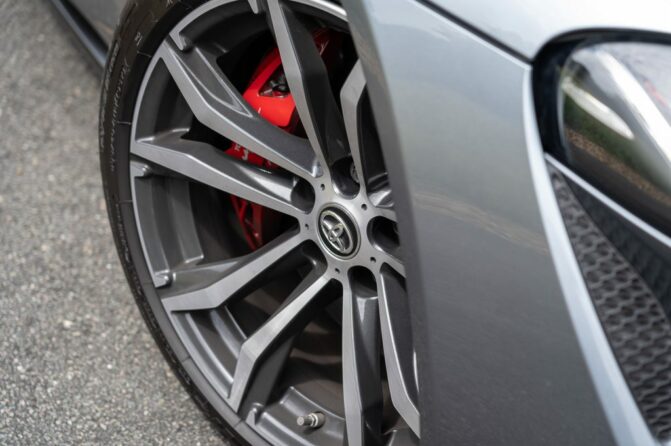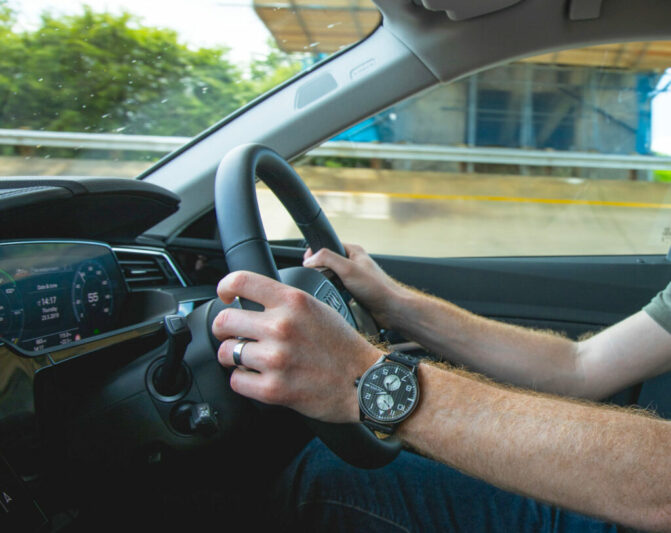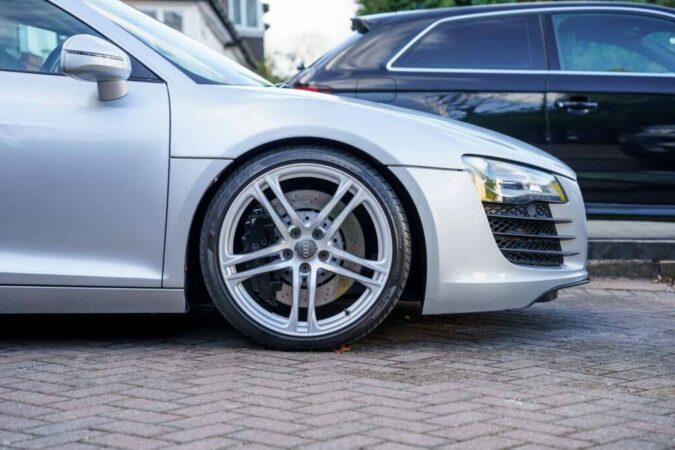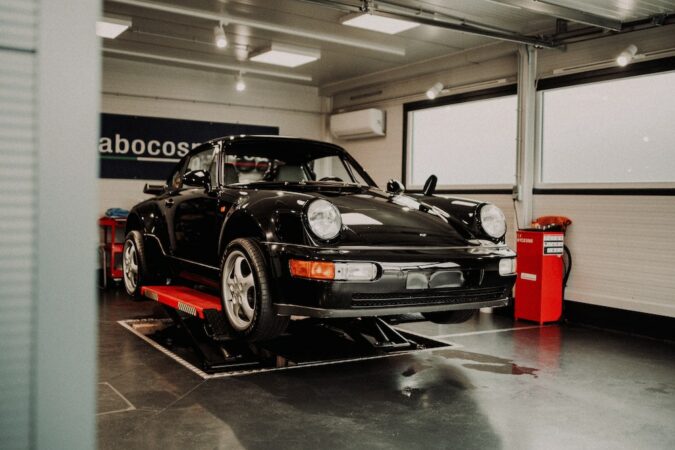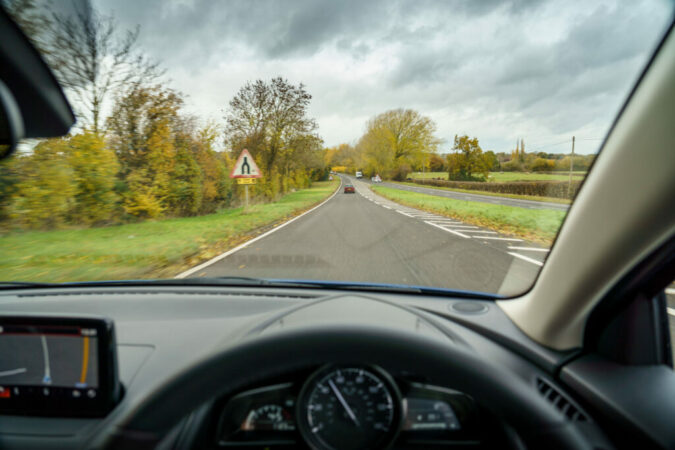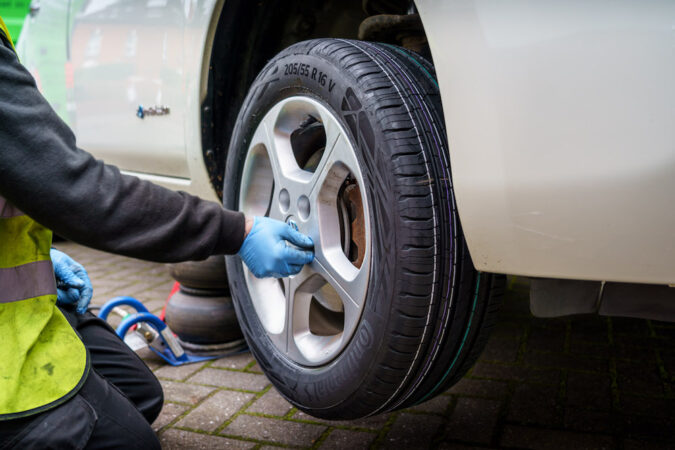Have you been looking to do a wheel alignment and you are confused by the terms toe in and toe out? If this is the situation you are in and you are looking to learn more about this problem. Then you are at the right place because there will be a lot to cover on this topic.
Learning things like this is quite essential if you want to perform the right alignment and also determine if you have a bad wheel alignment on your vehicle. And alignment plays a huge role in how a vehicle reacts on the road and how it behaves. In addition to this, it affects tire life and fuel economy.
Alignment also plays a huge role in tuning race suspensions and adjusting race cars for the track. In order to get the most out of them, the suspension has to be tweaked by professionals. All three aspects are camber, caster, and toe. And we are going to explain everything when it comes to them. But we will mostly focus on toe in. Since the article is all about this suspension tweak.
First, we will learn what is wheel alignment and the types of wheel alignment, which are camber, caster, and toe. We will primarily focus on the toe in aspect and learn more about it. Later we will discuss the symptoms of bad wheel alignment and how to fix it. In addition to this the cost to fix it. So, if you want to learn more about toe in, follow along.
What Is A Wheel Alignment?
So before we dive into discussing the toe in. Let’s first learn what is wheel alignment in general terms. This would be quite useful for the ones that are not that experienced with cars and do not know a lot about these issues. If you are already experienced and feel ready, you can jump to one of the following chapters, if not, keep up with us for a bit.
So, what is a wheel alignment? A wheel alignment is a procedure that is taken at a shop and with this procedure your car’s wheels are properly aligned.
When you look at the car and check the tires, you would probably say, there is nothing wrong with it. But the reality is different. A car’s suspension can easily get misaligned and you would start to experience the symptoms of bad alignment that we are going to cover later in this article.
There are multiple adjustment points on our car’s suspension and all of them need to be properly checked and adjusted for optimal performance. If one of them is not aligned, you would not feel safe driving the car on the street. So, your best bet would be to adjust it and call it a day.
You might be needed to pay a fee for this work. But the end result will be amazing and the car will drive like dream.
As we noted, there are a ton of points where the car is adjusted for the desired effect like for example toe in. And in the following chapters, we are going to discuss these types of adjustments in-depth.
Types Of Wheel Alignment
Now before we dive into the topic of toe in. Let’s first discuss all three types of wheel adjustment in depth. Before we start, let’s see what are the three basic types of adjustment. When we are discussing wheel adjustment, we talk about camber, caster, and toe.
These are the primary angles also known as the basic angle alignment. This alignment is relative to the other wheels and as well as to the body of the car. And in the following chapters, we are going to discuss them in-depth one by one.
Camber
Now before we cover the toe in, let’s first discuss camber. So, what is wheel camber? Wheel camber is basically any inward or outward tilt. There are two types of camber. An inward and outward camber.
The inward camber is when the top of the tire leans inward. This is also known as negative camber.
The outward camber is when the top of the tire is tilting outward. This camber is also known as positive camber.
What is important to note is that each manufacturer uses different camber on their vehicles. But most commuter cars are using zero camber. Meaning all of the wheels are straight at zero degrees.
In racing applications, the camber is used to improve the cornering ability of the vehicle. But what about toe in? We will get to that, now first let’s discuss the caster.
Caster
Before we cover the toe in, let’s first discuss the caster. The caster is the angle at which your suspension is placed. Imagine that the front strut is positioned straight from the center of the wheel, this is zero caster. If the strut is positioned at an angle, you can get positive and negative casters.
A negative caster is when the suspension is placed at a negative angle pointing to the front of the car and a positive caster is when the suspension is pointing to the rear of the car.
Most modern cars are using a positive caster angle. A positive caster angle has a good effect on the steering and the handling. Meaning that the higher the caster angle, the better the performance of the vehicle is at high speeds. Now let’s move on to the toe in.
Toe (Toe In & Toe Out)
Now before we discuss the toe in, let’s first learn what is toe in general. The simplest way to explain toe is that toe is basically the angle at which the tires are pointed while they are rotating.
This is the most common issue with cars that have bad alignment since this is the aspect where cars often fall out of alignment. Toe is the angle that affects the most when it comes to drivability and overall experience while you drive the car.
There are three types of a toe. Toe in is when both of the tires are pointing inward, there is zero toe when both of the tires are going dead straight and there is toe out, when the front tires are pointing outward.
You might assume that zero toe is the best setting for your car. Which is quite correct, to be honest. Tires should go dead straight and should not point in different directions. But sometimes wheels can get out of alignment and enter a toe in mode, or toe out or even one tire to point in and the other tire to point out. And this is something that you don’t want.
Even though, in race applications, the toe is adjusted specifically for the track to get the best performance out of the tire. Meaning that this toe in setting has some advantages and disadvantages. And in the following chapters, we are going to explain everything about this.
Advantages & Disadvantages Of Toe In
Now let’s focus on the advantages and disadvantages of toe in. As you know, everything has its positives and its negatives, and specifically, in this case, they are worth elaborating on.
After reading this, you will be able to know if you want to align your tires like this, what are the positives, and what are going to be the drawbacks from this action. So, without further ado, let’s dive into it.
Toe In Advantages
The advantages of the toe in are enormous if you are tracking your car. The car will have an increased grip and will accelerate like nothing else out there. All this is because of the increased slip angle in the tire. The more grip the faster the acceleration is.
Also, you can get the tires up to temperature far quicker with toe in alignment. The tire will be grippier and will heat up far quicker. Much quicker for example when the setup is adjusted at zero toe.
So, if you want to track your car, then toe in should be one of the first settings that you adjust on the car. But this toe in setup also has downsides to it. And we are going to cover them next.
Toe In Disadvantages
We have covered the advantages of toe in, now let’s discuss the disadvantages of this alignment setting. As we already told you, everything has its ups and downs and so does the toe in. So, what are they?
The biggest drawback of this setting is the slow steering response. With this type of setting the car might accelerate quicker and get up to speed. But the cornering ability would not be that good after all. The steering wheel will feel sluggish and not responsive. With toe in, you might have problems while cornering with the toe in.
Another big drawback is the tire life. The tire life will be quite reduced to only a few thousand miles instead of 30,000 miles or so. This is caused because the tires heat up when are adjusted like this and when the tire heats up, this takes a toll on it.
That’s why people with bad wheel adjustment have uneven wear and tear issues on their tires and their cars simply go through tires at a high pace. Because of this, adjustment is crucial.
Is It Safe To Drive Like This?
Whether or not it’s safe to drive with toe in depends much on the angle of the toe in. If it’s mild, then you would not have a problem driving like this.
But if the toe in is too large then you might have problems while cornering and your tire will squeal. And even more wear of the tires will happen.
So, we can conclude that driving like this on the street is not something that is recommended to do on a daily basis. And if your suspension is toe in, or misaligned. You need to perform an alignment to return the car in the factory spec.
Later in the article, we will go through some of the symptoms of bad wheel alignment and we will discuss them in detail, we will learn how the car behaves when the alignment is off and what are the repercussions of driving like this with toe in or toe out. Now let’s see one example of toe in system in motorsport.
Example Of Toe In Alignment In Motorsport
A great example of this toe in suspension setting is the Mercedes AMG DAS system that the Mercedes AMG used in the 2020 season before this system was banned. Also known as Dual-Axis Steering.
This was a mechanical system that increased the toe from zero toe into toe in at the straights. But why did it worked only on the straights?
Well, this system was activated by the driver. It became a big controversy back then when it was first introduced. Other teams freaked out and F1 banned it for the following season.
This system was activated by the driver after the last corner of the circle in order for the car to achieve higher speeds on the straights. The driver simply pulled the steering wheel toward himself and the toe angle went inward like in the case we cover with the toe in alignment.
This DAS system slightly improved the speed of the car on the straights. Even though controversial, Mercedes haven’t used it that much because the tires were suffering while pulling this maneuver. As we mentioned in the section on the downsides of the toe in. So, as you can see, even in motorsport there was not a big use when it comes to suspension settings like this.
The drawbacks are much greater than what you really get. So, most teams primarily focus on the camber and the caster in their pursuit of the best times possible. That’s all about the toe in. Now let’s discuss the symptoms of bad alignment.
Symptoms Of Bad Alignment, Toe In?
We have covered toe in and now let’s discuss the symptoms of overall bad alignment. Including toe in. There are a number of these symptoms that you are going to notice when your alignment is off by a margin.
Modern cars do not want positive or negative toe adjustment. The toe has to be close to zero in order for some of these symptoms to be avoided. Meaning that your wheels have to be aligned.
And trust me, if you haven’t aligned the wheels recently, they are out of alignment, that’s for sure. One wheel could have a positive toe, while the other could have a negative toe (toe out). And this is frankly the worst. You are battling with your steering wheel in this situation. But more on the symptoms that you are going to notice with the toe in we are going to cover in the following chapters. So, follow along.
1. Uneven Wear And Tear Of The Tires
The biggest symptom as we noted when you have a poor alignment. More precisely positive toe(toe in) creates a lot of tire wear.
Your tires would often not last even a few thousand miles when the alignment is off. And they should last about 30,000 miles on average. So, you can conclude how much this bad alignment is affecting these components.
Not to forget the cost of the tires which can be really high especially if you are running some low profile tires that are extra grippy.
Whenever you notice something like this, it means that the alignment is off and it needs to be readjusted at a shop before you install new tires because the new tires would also wear very quickly if the problem is not fixed.
2. Car Pulls To The Left Or Right
Another symptom that you would notice when you have a positive toe is the car pulling on one side while cornering.
As we noted, the car will not like this new setting and you can expect some symptoms like this. The car will pull to the left or to the right while catching a corner at high speed.
You might even lose control if you go all in. This could have some tragic consequences and you shouldn’t drive into a corner with a positive toe in at high speeds.
Go fast in the straight line, and when you come up to a corner, adjust the speed in the right manner and avoid crashing your vehicle. If you want to catch corners well, you will need to have zero toe, meaning all the wheels to be adjusted straight.
3. Vibrations At Higher Speeds Because Of Toe In
Another thing that you will notice is the vibrations with a positive toe. The car would love to grip more and will be throttle happy. But there will be an increase in the vibrations inside of the cabin.
This is often the case because the tires are pointing towards each other and are not straight. Anything that is not straight will suffer from vibrations and lack of controllability. The tires will heat up immensely and will be extremely difficult to drive the vehicle.
So, if the vibrations increase the faster you go, then this is a clear example of a positive toe also known as toe in. The solution for this would be to realign the suspension and bring it back to stock settings.
4. Squealing Tires At High Speed
And the last symptom that we are going to cover that is connected to toe in alignment is the symptom of the squealing tires.
The tires would love to produce sounds when the wheels are out of alignment. Why is this the case? Well, this is the case because the tires are pointing towards each other. And they are not designed by the factory to work this way. They are designed to be perfectly straight.
There will be all the time some vibrations and other noises while you drive a car with a toe in or toe out. But the squealing sounds when you catch a corner will be the most prominent symptom that there is something wrong. This means that the car needs to be properly aligned if you are not using it for racing or other stuff on the track. But how much does an alignment cost? How much does it fix the toe in? Let’s elaborate in the following chapter.
Cost To Align The Toe In?
The cost to do an alignment is also worth covering because whenever you have a situation like this on your commuter car, it has to be realigned because a commuter car is not a race car. By doing this you will increase the overall wear and tear in the suspension and also the overall wear and tear on the tires.
Not to forget the safety, which is another aspect that will be quite compromised by running your car like this. So, how much is the cost to do an alignment on a car with a positive toe also known as toe in?
Well, the cost can vary. There are places that offer this service for about $50 to $80. Some places even ask $120. But there are also places where you can do this work for about $40, which is quite insane, to be honest. And you probably want a deal like this.
If you do, go on Groupon.com, type in the search wheel alignment, and find the cheapest offer near your place. Thank me later. There are also other services like tune-ups, tire replacement and balancing, and much more. Don’t get ripped off when you can do these services on the cheap with little money. Now let’s conclude this article about toe in.
Wheel Alignment – Factors, Toe, Camber, and Caster
- Toe, camber, and caster are the three factors that affect wheel alignment, with toe being the easiest to check at home.
- Symptoms of alignment issues include uneven tire wear, vibration, odd handling, and pulling to one side after an impact or a sharp turn.
- Toe is the fore-and-aft difference in tire distance, and most vehicles are slightly toe-in for a lighter steering feel and to maintain a slight pre-load on wheel bearings.
- A saw-tooth wear pattern on both front tires is a sign of excessive toe-in.
- Camber measures tire lean and are easy to check with an angle finder and a straight edge. Most newer vehicles have slightly negative camber to improve stability and handling.
- An out-of-spec measurement of camber usually indicates bent or worn parts, and front-wheel-drive cars may not have adjustable camber.
- Caster is the angle of the steering pivot and affects vehicle stability. Most vehicles are designed with a slight negative caster to improve stability, while too much positive or negative caster can lead to steering problems and wheel hopping.
- Checking alignment at home can come in handy after replacing steering or suspension components, but correcting the caster often involves repairing or replacing chassis parts, so it’s best left to professionals.
- Irregular tire wear, such as a saw-tooth pattern or beveled wear, indicates alignment issues and should be checked promptly.
- Alignment tools for checking toe are available from aftermarket companies, and true toe specs are measured midway up the tires, with an off-center steering wheel having no effect on the final alignment.
Conclusion To Toe In
In this article, we have covered quite a bit when it comes to the tire alignment issue. We first learned what is wheel alignment and we learned all of the different angles of alignment. Which were castor, camber, and toe.
Then we covered the advantages and disadvantages of this in alignment and we gave one example where this suspension alignment was used in motorsport.
Then we covered the symptoms that you might notice when your suspension is in this mode. These were the bad cornering ability, tires squealing, vibrations, wear of the tires, and more. Lastly, we covered the wheel adjustment and how much it will cost you to bring your car back to stock settings.

